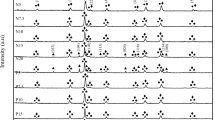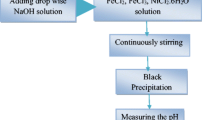Abstract
In the present work magnetite nanopowders were synthesized by chemical precipitation using FeCl3·6H2O and FeCl2·4H2O (80 °C, maintaining 5 min–1 h) and decomposition of FeC2O4 (470 °C, in hydrocarbon and nitrogen media maintaining 2 h) and investigated by X-ray diffraction analysis, IR spectroscopy and Scanning electron microscopy. Specific surface area and magnetic properties (specific saturation magnetization and coercive force) were also evaluated. It was shown that the time of synthesis did not influence on the phase composition and nanopowder with specific surface area equal to 141 m2/g could be prepared using chemical precipitation method for 5 min. Thermal decomposition method was found to allow obtaining of nanopowders with the higher degree crystallinity. It was established that increasing time of chemical precipitation causes decreasing the specific saturation magnetization from to 62 down to 53.5 emu/g and coercive force from 18.1 down to 3.0 Oe. Thermal decomposition method significantly improve magnetic properties and allow to obtain magnetite nanopowder with the specific saturation magnetization 135 emu/g.




Similar content being viewed by others
References
Abramov NV, Gorbyk PP (2012) Properties of ensembles of nanoparticles of magnetite, which are part of magnetic fluid designed for use in cancer therapy. Surface 4(19):246–265
Ahmad HMY, Salimi MN, Mohd F, Jamlos A (2018) Review: Synthetic strategy control of magnetite nanoparticles production. Adv Nano Res 6:1–19
Ali A, Zafar H, Zia M et al (2016) Synthesis, characterization, applications, and challenges of iron oxide nanoparticles. Nanotechnol Sci Appl 2(9):49–67
Alvarez S, Muhammed M, Zagorodni A (2006) Novel flow injection synthesis of iron oxide nanoparticles with narrow size distribution. Chem Eng Sci 61:4625
Arum Y, Song Y (2011) Oh J (2011) Controlling the optimum dose of AMPTS functionalized-magnetite nanoparticles for hyperthermia cancer therapy. Appl Nanosci 1:237–246
Atila Dinçer C, Am E, Karakeçili A, Yildiz N (2019) Preparation of chitosan and glycol chitosan coated magnetic nanoparticles loaded with carboplatin as anticancer drug. J Polytech 22(4):1017–1022
Basavaiah K, Pavan Kumar Y (2013) Prasada Rao AV (2012) A facile one-pot synthesis of polyaniline/magnetite nanocomposites by micelles-assisted method. Appl Nanosci 3:409–415
Berry CC, Curtis AS (2003) Functionalisation of magnetic nanoparticles for applications in biomedicine. J Phys D-Appl Phys 36(13):198–206
Bhaumik M, Maity A, Gupta VK (2017) Synthesis and characterization of Fe0/TiO 2 nanocomposites for ultrasound assisted enhanced catalytic degradation of reactive black 5 in aqueous solutions. J Colloid Interface Sci 1:403–414
Bragg WH (1915) The structure of magnetite and the Spinels. Nature 95(2386):561. https://doi.org/10.1038/095561a0
Cabrera L, Gutierrez S, Menendez N, Morales P, Herrasti P (2008) Magnetite nanoparticles: electrochemical synthesis and characterization. Electrochim Acta 53:3436
Chaki SH, Tasmira JM, Chaudhary MD, Tailor JP, Deshpande MP (2015) Magnetite Fe3O4 nanoparticles synthesis by wet chemical reduction and their characterization. Adv Nat Sci Nanotechnol 6:035009
Chiu WS, Radiman S, Abdullah MH, Khiew PS, Huang NM (2007) Abd-Shukor R (2007) One pot synthesis of monodisperse Fe3O4 nanocrystals by pyrolysis reaction of organometallic compound. Mater Chem Phys 106(2–3):231–235
Daoush WM (2017) Co-precipitation and magnetic properties of magnetite nanoparticles for potential biomedical applications. J Nanomed Res 5(3):400118. https://doi.org/10.15406/jnmr.2017.05.00118
Deng L, Ke X, He Z, Yang D, Gong H, Zhang Y, Jing X, Yao J, Chen J (2012) A MSLNtargeted multifunctional nanoimmunoliposome for MRI and targeting therapy in pancreatic cancer. Int J Nanomed 7:5053–5065. https://doi.org/10.2147/ijn.s3480
Dunlop DJ (1973) Superparamagnetic and single-domain threshold sizes in magnetite. J Geophys Res. https://doi.org/10.1029/JB078i011p01780
Estelrich J, Escribano E, Queralt J, Busquets M (2015) Iron oxide nanoparticles for magneticallyguided and magnetically-responsive drug delivery. Int J Molecul Sci 8:8070
Gao G, Shi R, Qin W, Shi Y, Xu G, Qiu G, Liu X (2010) Solvothermal synthesis and characterization of size-controlled monodisperse Fe3O4 nanoparticles. J Mater Sci. https://doi.org/10.1007/s10853-010-4378-7
Gehring AU, Hofmeister AM (1994) The transformation of lepidocrocite during heating: a magnetic and spectroscopic study. Clays Clay Miner 42(4):409–415
Ghandoor H, Zidan HM, Khalil Mostafa MH, Ismail MIM (2012) Synthesis and some physical properties of magnetite (Fe3O4)nanoparticles. Int J Electrochem Sci 1:5734–5745
Gingasu D, Minduru I, Patron LA (2011) Investigation of magnetite formation in the presence of hydrazine dihydrochloride. Digest J Nanomater Biostruct 6:3
Gotic M, Mössbauer S (2007) FT-IR and FE SEM investigation of iron oxides precipitated from FeSO4 solutions. J Mole Struct 1:834–836
Hong Y, Pan T, Li Z (2006) Microwave synthesis of magnetic Fe3O4 nanoparticles used as a precursor of nanocomposites and ferrofluids. J Magn Magn Mater 303:60
Johannsen M, Gneveckow U, Eckelt L et al (2005) Clinical hyperthermia of prostate cancer using magnetic nanoparticles: presentation of a new interstitial technique. Int J Hyperthermia 21:637–647. https://doi.org/10.1080/02656730500158360
Lemine OM et al (2012) Sol–gel synthesis of 8nm magnetite (Fe3O4) nanoparticles and their magnetic properties. Superlattices Microstruct 52:793–799
Li B, Weng X, Wu G, Zhang Y, Lv X, Gu G (2017) Synthesis of Fe3O4/polypyrrole/polyaniline nanocomposites by in-situ method and their electromagnetic absorbing properties. J Saudi Chem Soc 21:466–472
Liu M, Kim K (2009) Solvothermal synthesis and magnetic properties of magnetite nanoplatelets. Mater Lett 63:428
Lopez JA, González F, Bonilla FA, Zambrano G, Gómez ME (2010) Synthesis and characterization of Fe3O4 magnetic nanofluid. Rev Latinoam Metalurgia y Mater 30(1):60–66
Ma M, Zhang Y, Yu W, Shen HY, Zhang HQ, Gu N (2003) Colloid. Surf A 212:219–226
Mamani JB, Gamarra LF, Brito S (2014) Synthesis and characterization of Fe3O4 nanoparticles with perspectives in biomedical applications. Mater Res 17:542–549
Mohammadzadeh A, Sadri M, Salman S, Afghahi S, Alizadeh Y, Najafian S, Hosseini H (2017) In vitro biocompatibility of low and medium molecular weight chitosan–coated Fe3O4 nanoparticles. Nanomed Res J 2(4):250–259
Nishikawa S (1915) Structure of some crystals of spinel group. Math Phys Soc 8:199–209
Ozden O (2000) Coercive force of single crystals of magnetite at low temperatures. Geophys J Int 141:351–356
Petit S, Righi D, Madejová J (2006) Infrared spectroscopy of NH4+-bearing and saturated clay minerals: a review of the study of layer charge. Appl Clay Sci 34(1–4):22–30
Schwertmann U (1991) Cornell RM (2000) Iron oxides in the laboratory: preparation and characterization. Weinheim/VCH Publishers
Storozhuk L, Iukhymenko N (2019) Iron oxide nanoparticles modified with silanes for hyperthermia applications. Appl Nanosci 9:889–898. https://doi.org/10.1007/s13204-018-0777-x
Sun C et al (2010) PEG-Mediated synthesis of highly dispersive multifunctional superparamagnetic nanoparticles: their physicochemical properties and function in vivo. ACS Nano. https://doi.org/10.1021/nn100190v
Tieyu C, Xing P, Henry D (2006) Construction of site-specific core–shell structured nanocomposite for pH-controlled drug delivery. J Porous Mater 23:987–995. https://doi.org/10.1007/s10934-016-0156-5
Vega-Chacón J, Picasso G, Jafelicci A-Félix L (2016) Influence of synthesis experimental parameters on the formation of magnetite nanoparticles prepared by polyol method. Adv Nat Nanotechnol 7:015014
Venkatesan M, Nawka S, Pillai S, Coey D (2003) Enhanced magnetoresistance in nanocrystalline magnetite. J Appl Phys 93:8023
Waldron RD (1955) Phys Rev 99:1727–1735
Wang Z, Cuschieri A (2003) Tumour cell labelling by magnetic nanoparticles with determination of intracellular iron content and spatial distribution of the intracellular iron. Int J Mol Sci 14:9111–9125. https://doi.org/10.3390/ijms14059111
Wang XL, Wei L, Tao GH, Huang MQ (2011) Synthesis and characterization of magnetic and luminescent Fe3O4/CdTe nanocomposites using aspartic acid as linker. Chinese Chem Lett 22:233–236
Whitehead KA, Langer R, Anderson DG (2009) Knocking down barriers: advances in siRNA delivery. Nat Rev Drug Discov. https://doi.org/10.1038/nrd2742
Wulandari IO, Sulistyarti H, Safitri A, Santjojo Dionysius JDH, Sabarudin A (2019) Development of synthesis method of magnetic nanoparticles modified by oleic acid and chitosan as a candidate for drug delivery agent. J Appl Pharma Sci 9(07):001–011
Yusoff AHM, Salimi MN, Jamlos MF, Yusoff A (2017) Synthesis and characterization of biocompatible Fe3O4 nanoparticles at different pH. AIP Conf Proc 1:20010–20004
Zeinali S, Nasirimoghaddam S, Sabbaghi S (2016) Investigation of the synthesis of chitosan coated iron oxide nanoparticles under different experimental conditions. Int J Nanosci Nanotechnol 12(3):183–190
Author information
Authors and Affiliations
Corresponding author
Ethics declarations
Conflict of interest
The authors declare that there are no conflicts of interest regarding the publication of this manuscript.
Additional information
Publisher's Note
Springer Nature remains neutral with regard to jurisdictional claims in published maps and institutional affiliations.
Rights and permissions
About this article
Cite this article
Synytsia, A., Sych, O., Iatsenko, A. et al. Effect of type and parameters of synthesis on the properties of magnetite nanoparticles. Appl Nanosci 12, 929–937 (2022). https://doi.org/10.1007/s13204-021-01797-5
Received:
Accepted:
Published:
Issue Date:
DOI: https://doi.org/10.1007/s13204-021-01797-5




